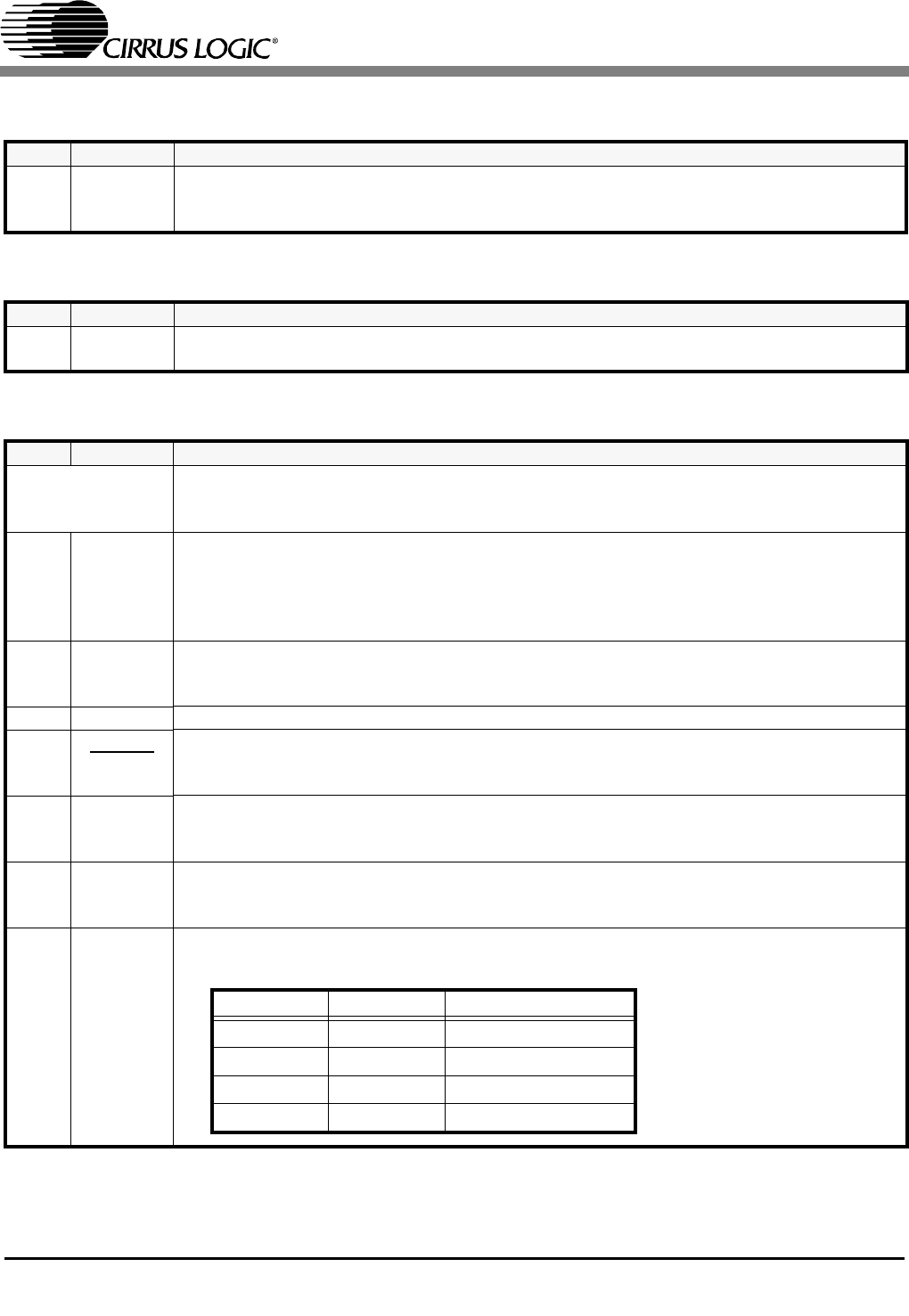User Manual
Table Of Contents
- Features
- Description
- 1. Pin Out - 144-Pin LQFP Package
- 2. Pin Out - 160-Ball FBGA Package
- 3. Pin Descriptions
- 4. operation
- 5. Power-up
- 6. Master Clock
- 7. G.772 Monitoring
- 8. Building Integrated Timing Systems (BITS) Clock Mode
- 9. Transmitter
- 10. Receiver
- 11. Jitter Attenuator
- 12. Operational Summary
- 13. Host Mode
- 14. Register Descriptions
- 14.1 Revision/IDcode Register (00h)
- 14.2 Analog Loopback Register (01h)
- 14.3 Remote Loopback Register (02h)
- 14.4 TAOS Enable Register (03h)
- 14.5 LOS Status Register (04h)
- 14.6 DFM Status Register (05h)
- 14.7 LOS Interrupt Enable Register (06h)
- 14.8 DFM Interrupt Enable Register (07h)
- 14.9 LOS Interrupt Status Register (08h)
- 14.10 DFM Interrupt Status Register (09h)
- 14.11 Software Reset Register (0Ah)
- 14.12 Performance Monitor Register (0Bh)
- 14.13 Digital Loopback Reset Register (0Ch)
- 14.14 LOS/AIS Mode Enable Register (0Dh)
- 14.15 Automatic TAOS Register (0Eh)
- 14.16 Global Control Register (0Fh)
- 14.17 Line Length Channel ID Register (10h)
- 14.18 Line Length Data Register (11h)
- 14.19 Output Disable Register (12h)
- 14.20 AIS Status Register (13h)
- 14.21 AIS Interrupt Enable Register (14h)
- 14.22 AIS Interrupt Status Register (15h)
- 14.23 AWG Broadcast Register (16h)
- 14.24 AWG Phase Address Register (17h)
- 14.25 AWG Phase Data Register (18h)
- 14.26 AWG Enable Register (19h)
- 14.27 Reserved Register (1Ah)
- 14.28 Reserved Register (1Bh)
- 14.29 Reserved Register (1Ch)
- 14.30 Reserved Register (1Dh)
- 14.31 Bits Clock Enable Register (1Eh)
- 14.32 Reserved Register (1Fh)
- 14.33 Status Registers
- 15. Arbitrary Waveform Generator
- 16. JTAG Support
- 17. Boundary Scan Register (BSR)
- 18. Applications
- 19. Characteristics and specifications
- 19.1 Absolute Maximum Ratings
- 19.2 Recommended Operating Conditions
- 19.3 Digital Characteristics
- 19.4 Transmitter Analog Characteristics
- 19.5 Receiver Analog Characteristics
- 19.6 Jitter Attenuator Characteristics
- 19.7 Master Clock Switching Characteristics
- 19.8 Transmit Switching Characteristics
- 19.9 Receive Switching Characteristics
- 19.10 Switching Characteristics - Serial Port
- 19.11 Switching Characteristics - Parallel Port (Multiplexed Mode)
- 19.12 Switching Characteristics- Parallel Port (Non-Multiplexed Mode)
- 19.13 Switching Characteristics - JTAG
- 20. Compliant Recommendations and specifications
- 21. 160-Ball FBGA package dimensions
- 22. 144-Pin LQFP Package dimensions

CS61880
DS450PP3 37
14.14 LOS/AIS Mode Enable Register (0Dh)
14.15 Automatic TAOS Register (0Eh)
14.16 Global Control Register (0Fh)
BIT NAME Description
[7:0] LAME 7-0 Setting bit n to “1” enables ETSI 300 233 compliant LOS/AIS for channel n; setting bit n to “0”
enables ITU G.775 compliant LOS/AIS for channel n. Register bits default to 00h after
power-up or reset.
BIT NAME Description
[7:0] ATAO 7-0 Setting bit n to “1” enables automatic TAOS generation on channel n when LOS is detected.
Register bits default to 00h after power-up or reset.
BIT NAME Description
This register is the global control for the AWG Auto-Increment, Automatic AIS insertion,
encoding/decoding and the jitter attenuators location, FIFO length and corner frequency for
all eight channels. Register bits default to 00h after power-up or reset.
[7] AWG Auto-
Increment
The AWG Auto-Increment bit indicates whether to auto-increment the AWG Phase Address
Register (17h) (See Section 14.24 on page 39) after each access. Thus, when this bit is set,
the phase samples address portion of the address register increments after each read or
write access. This bit must be set before any bit in the AWG Enable register is set, if this
function is required.
[6] RAISEN
On LOS, this bit controls the automatic AIS insertion into all eight receiver paths.
0 = Disabled
1 = Enabled
[5] RSVD RESERVED (This bit must be set to 0.)
[4] CODEN
Line encoding/decoding Selection
0 = HDB3
1 = AMI
[3] FIFO
LENGTH
Jitter Attenuator FIFO length Selection
0 = 32 bits
1 = 64 bits
[2] JACF
Jitter Attenuator Corner Frequency Selection
0 = 1.25 Hz
1 = 2.50 Hz
[1:0] JASEL [1:0]
These bits select the position of the Jitter Attenuator.
Table 11. Jitter Attenuator Position Selection
JASEL 1 JASEL 0 POSITION
0 0 Disabled
01Transmit Path
1 0 Disabled
1 1 Receive Path










